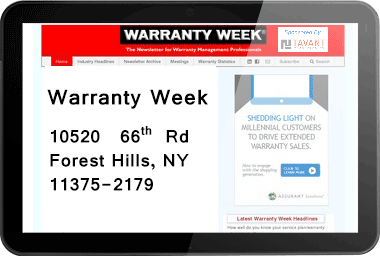November 15, 2012 |

|
ISSN 1550-9214 |
Warranty Estimates, Part 2:Automotive companies are supposed to carefully estimate the size of their warranty liabilities. But sometimes, their estimates are too low, and the amount they set aside is too meager to pay all their expected claims.Warranty is incredibly important in the automotive industry. In the U.S., automotive warranty claims account for about half of all product warranty expenses, while everything from airplanes to air conditioners makes up the remaining half. In the passenger car industry, one cannot produce an advertisement that fails to mention the vehicle's factory warranty. It's become a coded way of touting the product's quality and reliability. So what message does a company's warranty accounting deliver? Thanks to decade-old accounting reforms, we now know how much they spend on warranty. But is that more or less than their competitors? And is it enough to cover all their warranty expenses? It's hard to say whether an estimate is right or wrong until it can be looked at in the past tense. Some companies legitimately expect their warranty expenses to always be minimal, until they aren't. And they don't know how wrong their estimates are until it's too late. Earnings take a hit and investors are told there's been a manufacturing excursion. Sometimes, a company goes bankrupt and announces that it won't be paying warranty claims. There's no money left. If there was a warranty reserve, it wasn't big enough, or it was merely a bookkeeping entry with no actual cash to back it up. Either way, the remaining warranty liabilities will join the company's other liabilities in the bankruptcy proceedings. But how much is enough? One would think there should be enough in a warranty reserve fund at any given moment to pay all claims on all warranties valid at that moment. But this is rarely the case. As we shall see, in the automotive industry, while the warranties may last 24 or 36 months, the warranty reserves are more likely to last only 15 to 24 months. Warranty CalculationsIn each of the four charts below, we started out with four warranty metrics and ended up with two others. The first metric we collected was the dollar amount of product sales for the period in question. The second and third metrics were the amount spent on warranty claims, and the amount set aside as warranty accruals, during the corresponding sales period. And the fourth metric was the balance in the warranty reserve fund at the end of each of the past 38 quarters (9-1/2 years). We repeated these data collections for each of the quarters between early 2003 and the middle of 2012. Then we grouped the companies by the types of vehicle they sold. If they sold more than one type of vehicle, for instance trucks and buses, they were counted in each category into which they belonged. Then we took the four basic metrics and combined them to create two new metrics. The amount set aside as warranty accruals was divided by the dollar amount of product sales for the period in question. This created a percentage that is labeled in the charts below as the accrual rate. For instance, if a company sells $10 million worth of product and sets aside $200,000 in warranty accruals, its accrual rate would be 2.0%. Then we took the ending balance in the warranty reserve fund, and divided it by the amount being spent per month on warranty claims. This created a metric we're calling the warranty reserve capacity, expressed as the number of months of claims coverage in the fund. For instance, if the reserve fund contained $6 million and the company was spending $500,000 a month on warranty claims, the reserve capacity would be 12 months. The charts below track two key assumptions that a company has to make: how much money should we set aside to pay future warranty claims, and are we keeping enough in the reserve given the length and cost of our warranties? In each industry, and for each product line, the answers will be different. And of course, there's no one right answer for all the companies in a given industry. But by showing the averages of all the companies in a given industry or industry segment, we're tracking the best estimates of all those companies combined. So what we're really doing is charting the warranty estimates of all a given industry segment's members as a scatter plot. Warranty Accounting TheoryA company is supposed to set aside enough funds at the time a product is sold to cover all the warranty liabilities the company expects. So if the maker of a $20,000 vehicle expects $500 in warranty expense over the life of its warranty, they're supposed to set that amount aside at the time of sale. They may not spend it all. They may spend more. But they're supposed to estimate the cost and accrue that amount. If the warranty were for 48 months and if sales remained flat, the result of that accrual estimate would cause the company's accrual rate to remain flat at 2.5%. And if claims were paid at a constant rate of $125 per vehicle per year for four years, the claims rate would also be flat. After a while, the warranty reserve fund would contain exactly 48 times as much as was spent in a month, which would give it a reserve capacity of 48 months. And this would be fortunate, because the company's warranties would expire after that amount of time. If, for whatever reason, the company stopped selling vehicles, there should be exactly enough money in the warranty reserve fund to pay all claims until the last warranty expired. At least that's the theory. Warranty Accounting RealityThe reality is that nothing stays the same. Claims never emerge at a constant rate per year or per month. And even if they did, other factors such as the timing of payments and supplier reimbursements would throw that tidy schedule off. And in the automotive industry in particular, some warranties expire on usage before their time is up. Also, product sales rise and fall, and product lines change. However, the basic theory remains: At any given moment, there should be enough money in the warranty reserve to pay all remaining claims for products already sold. And if a company's products carry a 48-month warranty, the capacity of that warranty reserve fund (its balance divided by claims paid per month) ought to be somewhere close to 48 months. In the figures below, we're measuring the real world fluctuation of a given product type's warranty metrics. The value of the vertical axis should be close to its average warranty duration. The value of the horizontal axis should be close to its expected warranty cost. In Figure 1, we're comparing the scatter plots of three groups in the automotive supply chain. The red dots are an average of 49 automotive OEMs past and present, who make everything from golf carts to bulldozers. The green dots are an average of 28 drivetrain manufacturers, making engines, transmissions, gear boxes, axles, and other components. And the blue dots are the parts suppliers. There is some overlap -- for instance Navistar is counted as both an OEM and as an engine manufacturer. And in subsequent slides, Navistar is triple counted as a truck, bus and recreational vehicle manufacturer. All manufacturers are included in all categories into which they fit. Figure 1 |
||||||||||||||||||||||||||||||||||||||||||||||||||||||||||||||||||||||||||||||||||||||||||||||||||||||||
| ||||||||||||||||||||||||||||||||||||||||||||||||||||||||||||||||||||||||||||||||||||||||||||||||||||||||












